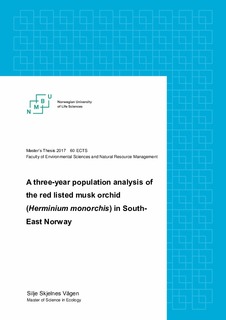| dc.contributor.advisor | Klanderud, Kari | |
| dc.contributor.advisor | Evju, Marianne | |
| dc.contributor.author | Vågen, Silje Skjelnes | |
| dc.coverage.spatial | Norway | nb_NO |
| dc.date.accessioned | 2017-11-26T12:55:42Z | |
| dc.date.available | 2017-11-26T12:55:42Z | |
| dc.date.issued | 2017 | |
| dc.identifier.uri | http://hdl.handle.net/11250/2468075 | |
| dc.description.abstract | The combination of abandonment and intensification of agriculture has changed the agricultural landscape, especially the semi-natural nature types. This has led to a loss and endangerment of species linked to these nature types. The musk orchid is one of these species. In Norway, the species is now only found in Hvaler municipality, South-East Norway, and is listed as critical endangered (CR) in the Norwegian red list.
My master’s thesis is a part of an ongoing project that started in 2014 by a former master student, where I collected data in 2016 and analysed the datasets from 2014 to 2016. The purpose of this thesis is to get a better understanding of how the last populations of musk orchid in Norway are performing, which the management authorities can use in further management. To answer this I had three main questions; i.e. (1) how the environmental factors are differing between the three locations and through the three years, (2) how the musk orchid population performance at the three locations differed over the three years, and (3) how grazing affects the two sub-populations, at one of the locations, three years after grazing ended.
My results suggest that both the abiotic and biotic environmental factors are impacting the three locations differently, and the performance of the musk orchid are correlating this. The smallest individuals and lowest fertile proportion of musk orchid are found at the driest location, which also had the lowest surrounding vegetation. At the wettest location, the trend is the opposite. It also seems like grazing influences the musk orchid even three years after the area has been grazed the last. The musk orchid in the grazed sub-population is larger and have a higher proportion of fertile plants.
In further management of the musk orchid at Hvaler it is crucial to continue the monitoring, to detect the whole population ant its dynamics. Another important management mean is to either hay or have grazing that will open and keep the surrounding vegetation down. But before any reintroduction of grazing at the locations which are not currently grazed, it is important to find a livestock density, size or race that will not hurt the musk orchid populations, as well as excluding grazing when the musk orchid is in the fertile stage. | nb_NO |
| dc.description.abstract | Kombinasjon av opphøyr og intensivering av jordbruksland har endra jordbrukslandskapet, og spesielt dei semi-naturlege naturtypane. Denne endringa har resultert i eit biomangfaldtap og trugar artar som er assosiert til desse naturtypane. Honningblomen er ein av desse artane. I Noreg er arten no berre funnen i Hvaler kommune, Søraust Noreg, og er lista som kritisk truga (CR) på den norske raudlista for artar.
Eg fortsette eit prosjekt som byrja i 2014 av ein tidlegare masterstudent, der eg samla data i 2016 og analyserte datasetta frå 2014 til 2016. Føremålet med oppgåva mi er å få ei betre forståing over korleis dei siste honningblom-populasjonane presterer, slik forvaltinga kan bruke denne informasjonen til vidare forvalting. Dette vart gjort ved å spørje tre hovudspørsmål; (1) korleis miljø faktorane varierer mellom dei tre ulike lokalitetane og mellom dei tre åra, (2) korleis planta presterte i dei tre ulike lokalitetane mellom dei tre åra, og (3) korleis beiting påverkar, sjølv etter opphøyr av beiting i to sub-populasjonar i ein av lokalitetane.
Resultata mine tilseier at dei tre ulike lokalitetane har forskjellig påverknad frå både dei biotiske og abiotiske miljøforholda eg målte, og at honningblom prestasjonen korrelerte med disse. Den tørraste lokaliteten hadde den kortaste omliggjande vegetasjonen, her var honningblomen minst og hadde den lågaste fertile andelen av dei tre lokalitatetane. I den våtaste lokaliteten var trenden motsett. Det ser òg ut til at beiting har ein effekt på honningblom, sjølv tre år etter at beitinga opphøyrde. Honningblom i den beita sub-populasjonen hadde større planter samt høgare proporsjon av fertile planter samanlikna med den andre sub-populasjonen.
For vidare forvalting av honningblom på Hvaler er det særs viktig å fortsette overvåkinga, for å oppdage heile populasjonen og dynamikken i den. Det er òg viktig å anten drive med slått eller beiting som vil kunne opne opp og halde vegetasjonen nede. Før ein eventuelt gjeninnfører beiting i dei lokalitetane der det ikkje er beiting nå, er det viktig å finne ein beitedyrs- tetthet, størrelse og type som ikkje vil skade honningblom populasjonane. Samt halde beitedyr vekke når honningblom er i sitt fertile stadie. | nb_NO |
| dc.description.sponsorship | Fylkesmannen i Østfold | nb_NO |
| dc.language.iso | eng | nb_NO |
| dc.publisher | Norwegian University of Life Sciences, Ås | nb_NO |
| dc.rights | Navngivelse 4.0 Internasjonal | * |
| dc.rights.uri | http://creativecommons.org/licenses/by/4.0/deed.no | * |
| dc.subject | musk orchid | nb_NO |
| dc.subject | Herminium monorchis | nb_NO |
| dc.subject | nature management | nb_NO |
| dc.subject | population analysis | nb_NO |
| dc.subject | red listed species | nb_NO |
| dc.title | A three-year population analysis of the red listed musk orchid (Herminium monorchis) in South-East Norway | nb_NO |
| dc.type | Master thesis | nb_NO |
| dc.description.version | submittedVersion | nb_NO |
| dc.subject.nsi | VDP::Matematikk og Naturvitenskap: 400::Zoologiske og botaniske fag: 480::Økologi: 488 | nb_NO |
| dc.subject.nsi | VDP::Landbruks- og Fiskerifag: 900::Landbruksfag: 910::Naturressursforvaltning: 914 | nb_NO |
| dc.subject.nsi | VDP::Matematikk og Naturvitenskap: 400::Zoologiske og botaniske fag: 480::Vegetasjonshistorie: 495 | nb_NO |
| dc.subject.nsi | VDP::Matematikk og Naturvitenskap: 400::Zoologiske og botaniske fag: 480::Plantegeografi: 496 | nb_NO |
| dc.source.pagenumber | 26 | nb_NO |
| dc.description.localcode | M-ECOL | nb_NO |

